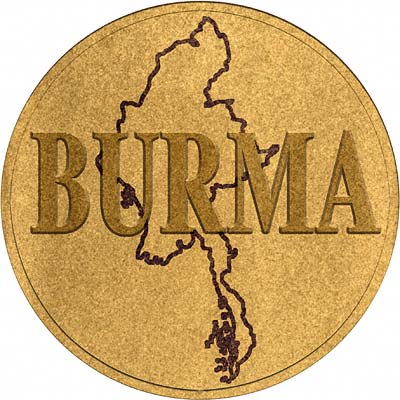| The Very Highest Quality Information... |
| Burma and Burmese Coins |
|
| ||||||||||||||||||||||||||||||||||||

| ||||||||||||||||||||||||||||||||||||
|
| ||||||||||||||||||||||||||||||||||||
Kingdom of Burma
Prior to British colonisation, Burma was a kingdom ruled by the Konbaung dynasty. The Kongbaung dynasty had managed to unite Burma when King Bodawpaya annexed Rakhine in 1784. The Burmese Empire continued to expand in the early 19th Century, taking Manipur in 1813 and Assam in 1821. However, once they came into contact with the British, Burmese fortunes began to decline.
British Conquest
In addition to mercantile considerations, Britain was concerned about the security of India on the border of the expansionist Burmese. However, the British also had another motive for adopting an aggressive attitude towards Burma. They were concerned that if they did not seize territory from Burma, the French, expanding their way from Indochina and Laos, would, and they could pose an even more serious threat to the security of India.
In 1824 the first of three Anglo-Burmese wars began which culminated in the eventual conquest of Burma by the British Empire in 1885. The First Anglo-Burmese War started with considerable difficulty for the British, until superior technology won the day. The British took Mergui, Tavoy and Ye, and claimed protectorate status over Assam and Manipur.
The Second Anglo-Burmese War of 1852 saw the loss of Rangoon and Lower Burma, and finally, the Third Anglo-Burmese war resulted in the defeat and annexation of the rest of Burma.
British Rule in Burma
Burma was originally governed as a province of British India. Although trade and economic prosperity flourished under British rule, the Burmese as a whole did little to profit from this, as Burma was flooded with Indian immigrants who drove wages down. Anti-British and ant-Indian sentiment was therefore quite high.
In 1937, Burma was separated from India and governed as a separate colony, to the relief of many Burmese nationalists, whose next goal was independence from Britain. However, in 1942, the Japanese invaded Burma. The Japanese tried to exploit anti-British sentiment in Burma by raising an army amongst the Burmese, known as the Burma Independence Army (later renamed the Burma National Army) in order to fight the British and declaring Burma to be ‘independent’.
In practice however, this puppet Burmese state was very much under the Japanese boot, and many Burmese were rounded up a murdered by the Japanese if they were suspected of harbouring anti-Japanese sympathies. Aung San, one of the Burmese nationalists who had received military training from the Japanese, turned against them and secretly cooperated with the British, helping to lead a guerrilla campaign against the Japanese to aid the British advance back into Burma.
Burmese Independence
The end of World War II was the beginning of the end for the British Empire, and negotiations for independence began the following year. Aung San, now one of the leading Burmese figures, looked set to become the first Prime Minister of an independent Burma, but in July 1947, just months before Burmese independence was achieve in 1948, he was assassinated along with much of his cabinet as part of a conspiracy led by U Saw, a former Prime Minister of Burma. U Saw was captured and executed for his part in the assassination, and Aung San’s place as Burma’s national hero was secured for eternity.
Anti-British feeling was still high in Burma, and unlike most former British colonies, Burma decided not to join the Commonwealth upon independence.
Post War Burma
Burma’s fragile democracy, marred by communist insurgency, imploded in 1962 when a coup d’état brought the military to power under Ne Win, who remained in power until 1981 under a program of a movement known as ‘The Burmese Way to Socialism’. The military has remained in power ever since this coup, and its garbled policies mixing Marxism, nepotism, thuggery and local superstition have resulted in a country that is probably second only to North Korea in terms of the poverty of its people and lack of basic freedoms.
In 1990, Aung San Suu Kyi, the daughter of Aung San led her National League for Democracy (NLD) Party to victory in a general election called by the military junta. The military refused to hand over power however, and placed Augn San Suu Kyi under house arrest instead. Although she was released in 2010, the Junta remains in power and she is kept under constant supervision.
Burmese Coins
The kingdom of Burma used the Kyat until 1889, which was divided into 20 pe, each of which was divided into 4 pya. Once the British took over Burma, they replaced the Kyat with the India Rupee at par. Although a separate, but equal currency known as the Burmese Rupee was introduced in 1937 when Burma became a separate colony, only banknotes were issued in the name of this currency, and Indian coins continued to be used until 1952, when the Kyat was reintroduced, this time it was a decimal currency divided into 100 pya.
The initial series of coins in Independent Burma were of 1, 5, 10, 25 and 50 pyas and 1 kyat. Inflation saw the demise of the 1 pya coin in 1966 followed by the 5 in 1987 and finally the 10 and 50 in 1991.
Since 1999, coins of 1, 5, 10, 50 and 100 kyat have been issued for use in circulation. The pya sub-denomination now only exists in theory.
For Sale and Wanted
If you are interested in coins from Burma please see our product index:-
Burmese Coins
Gold Coins
We also have gold coins from Burma on our taxfreegold website:-
Burmese Gold Coins
| ...at the Lowest Possible Price |
|
32 - 36 Harrowside, Blackpool, Lancashire, FY4 1RJ, England.
Telephone (44) - (0) 1253 - 343081 ; Fax 408058; E-mail: info@chards.co.uk The URL for our main page is: https://24carat.co.uk |
Web Design by Snoop |